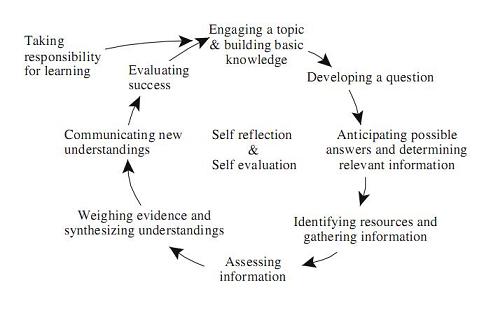Inquiry-Based Learning
General
Inquiry-based learning (also enquiry-based learning, inquiry learning or inquiry-guided learning) is a constructivist instructional strategy widely adopted in the 1970s1) and based on John Dewey's views on learning as active, learner-centered process which should be based on real-world examples instead of rote fact memorization. Inquiry represents questioning which fosters curiosity in students. Although different authors suggest different inquiry-based strategies, they are usually used to promote alone or collaborative,
“
active, and increasingly independent, investigation of questions, problems and issues, often for which there is no single answer.”
2)
What is inquiry-based learning?
The idea of inquiry-based learning is to foster characteristics of good learners and encourage them in the educational process. These characteristics include confidence in the ability to learn, enjoying problem-solving, trusting one's own judgement, not fearing being wrong, a flexible point of view, and respect for facts.3) These qualities can be fostered through an approach in which the teacher4):
rarely tells the students what they need to know since that would reduce their excitement in finding things out on their own,
interacts with students mostly through questioning and encourages students to interact among themselves,
does not accept short answers, but rather tries to deepen them by further questioning,
rarely summarizes what students' discussion and what they have learned since learning is a continuous process.

The inquiry-based process of learning can be described as a cycle based on these activities mainly through following main steps:
Questioning and curiosity provoked through questioning by the teacher together with taking the responsibility for their own learning by the students starts this process of learning.
Investigation, gathering of information and studying materials, observing and other related activities are then expected to be performed by the students.
This is followed by a synthesis of collected information, building hypotheses and possible explanations and planing on how to prove them.
Development and presentation of explanations. New questions may arise at this point.
Reflection on the original question, the research path, and the conclusions. Newly arisen questions form the beginning of a new cycle.
These steps in general are quite similar to the steps of problem-based learning. Differences between these two approaches are minimal according to some5) and appear only in their origins (problem-based learning was developed in medical education and inquiry-based learning in science education), other suggest it is the role of the teacher:
“
In an inquiry-based approach the tutor is both a facilitator of learning (encouraging/expecting higher-order thinking) and a provider of information. In a PBL approach… the tutor does not provide information related to the problem — that is the responsibility of the learners.”.
6)
Some authors suggest different inquiry-based learning modes depending on the level of scaffolding7):
structured inquiry - when teacher presents a problem and main frames for addressing it,
guided inquiry - when teacher provides questions to motivate students, but the research they do is self-directed, and
open inquiry - when students formulate questions and investigate them themselves.
Advantages of inquiry-based learning are increase in students motivation, active approach to learning, academic skills and intellectual habits8). Students are also encouraged to develop of critical thinking, reflect on their learning, use different learning resources and gain deeper understanding of the course concepts.9)
Various areas in which inquiry-based learning has been applied include ecology, endocrinology, political communication, engineering and sociology10).
What is the practical meaning of inquiry-based learning?
An example of inquiry-based learning is learning about language using a Star-Trek episode as a motivator11). In the Star Trek: The Next Generation episode “Darmok” viewers are introduced to the concept of Tamarian language spoken by an alien civilization. Weather this invented language could be an actual human language was debated by many professional linguists. A possible instructional plan for learning about language characteristics based on this episode is the following:
Show students the “Darmok” episode
Pose the problem to them: could Tamarian be a human language?
Provide students with resource materials or encourage them to look them up themselves.
Assist them if necessary on how to research the question and conduct analysis of language properties.
Analysis of results and reflection.
Criticisms
Keywords
Bibliography
Centre for Teaching and Learning: What Is Inquiry-Based Learning? Queen's University. Retrieved April 26, 2011.
Postman, Neil, and Charles Weingartner. Teaching as a subversive activity. Dell, 1980.
Lane, J. Inquiry-based Learning. Schreyer Institute for Teaching Excellence, Penn State. 15th September 2007.
Inquiry Page. University of Illinois. Retrieved April 26, 2011.
Spronken-Smith, Rachel, and Rebecca Walker. Can inquiry-based learning strengthen the links between teaching and disciplinary research? Studies in Higher Education 35, no. 6: 723-740. September 2010.
Read more
Johnston, James Scott. Inquiry and education: John Dewey and the quest for democracy. SUNY Press, 2006.
Benson, Chris, and Christian, Scott. Writing to make a difference: classroom projects for community change. Teachers College Press, 2002.
Brew, A. The nature of research: Inquiry in academic contexts. New York : Routledge/Farmer. 2001.
Allen, P. and Greeves, H. Inquiry-based learning: A case study in Asian Studies. HERDSA News, 21-23. April 2005.